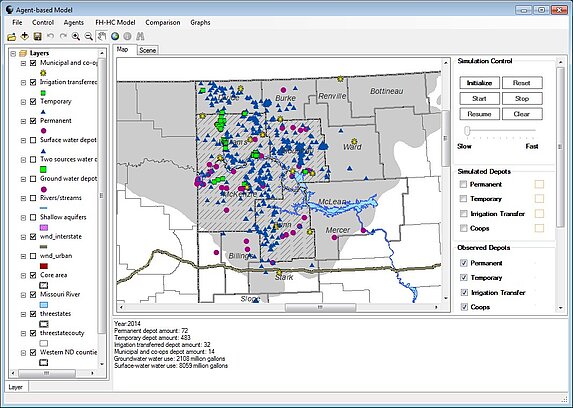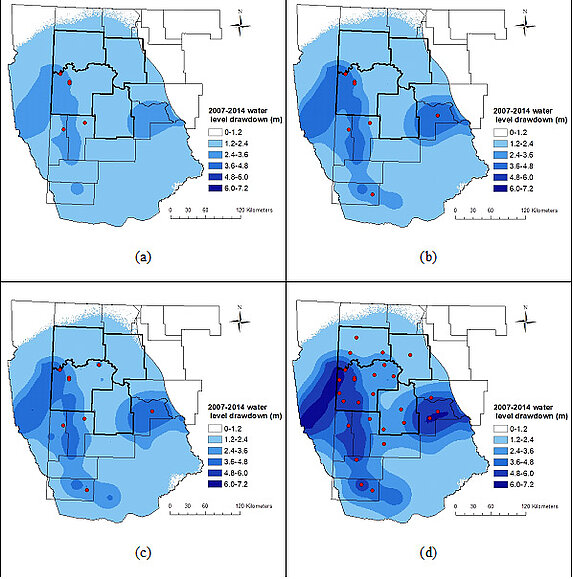Modeling Coupled Human and Natural Systems for Water Resources Management in the Bakken Region of Western North Dakota
Tong Lin is a Ph.D. student in Environmental & Conservation Science at North Dakota State University. He holds a Bachelor of Science degree in Geography Information Systems from Anhui Normal University, China. His current research is to develop an agent-based model and integrate the agent-based model with the SWAT model and groundwater model to simulate the streamflow and groundwater level changes under different scenarios. The main purpose of his work is to address the growing concerns about the water competition in the Bakken region of western North Dakota and to support making scientifically sound policies in water allocation and management for hydraulic fracturing.
Modeling Coupled Human and Natural Systems for Water Resources Management in the Bakken Region of Western North Dakota
An agent-based model (ABM) is developed to simulate the impacts on streamflow and groundwater levels by the dramatic increase of hydraulic fracturing (HF) water use. To develop the agent-based model, institution theory is used to model the regulation policies, while evolutionary programming allows agents to select appropriate strategies when applying for potential water use permits. Cognitive maps endow agents’ ability and willingness to compete for more water sales. All agents have their influence boundaries that restrict their competitive behavior toward their neighbors but not to non-neighboring agents. The decision-making process is constructed and parameterized with both quantitative and qualitative information. By linking institution theory, evolutionary programming, and cognitive maps, our approach is a new exploration of modeling the dynamics of coupled human-natural systems (CHNS) to address the high complexity of the decision-making process involved in the CHNS. The ABM is calibrated with HF water-use data, and the calibration results show that it is reliable in simulating water depot number, depot locations, and depot water uses. The SWAT (Soil and Water Assessment Tool) model of the Little Muddy River basin and the MODFLOW of the Fox Hill-Hell Creek regional aquifer are coupled with the ABM to simulate the changes in streamflow and groundwater level, respectively, under different scenarios such as HF water demand, climate, and regulatory policies. The integrated modeling framework of ABM, SWAT, and MODFLOW can be used to support making scientifically sound policies in water allocation and management for hydraulic fracturing.
Project Objectives:
The major objectives of this study include:
- To explore different behavior theories in developing an agent-based model of simulating the dynamics of the water depot-based water allocations system;
- To apply the agent-based model in the Bakken area of western North Dakota by calibrating the model against real-world hydraulic fracturing water use data and conducting sensitivity analysis for model parameters; and
- To integrate the agent-based model with the SWAT model, and groundwater model to simulate the streamflow and groundwater level changes under different scenarios, and to make policy recommendations to manage the water resource.
Progress
The agent-based model based on the water depot allocation system is developed and calibrated previously.
SWAT model
We developed a SWAT model for the Little Muddy River. The SWAT model was also calibrated, and the calibration results show that it can simulate the streamflows in the Little Muddy River fairly well. The agent-based model was coupled with this SWAT model to simulate the streamflow of the Little Muddy River under thirteen scenarios, including HF water demand increase, precipitation decrease, population increase, and policy change scenarios. The scenario analysis results indicate that precipitation and policy changes are generally the more influential factors than the HF water demand and the regional population increases in reducing the streamflows in the Little Muddy River. When the precipitation decreases to the 30-year normal precipitation level, the HF water demand has a more significant impact on the average annual seven-day low flows compared with the annual average flows.
Groundwater model
The agent-based model was then loosely coupled with a developed MODFLOW groundwater model. The coupled models were designed to simulate the groundwater level changes of the Fox Hill-Hell Creek aquifer under fourteen scenarios. The results show that the hydraulic fracturing water demand scenarios, the population increase scenarios, the precipitation scenarios, and two policy change scenarios did not cause any changes in the groundwater drawdown because of the industrial water use restriction policy on the aquifer. However, when the industrial water-use restriction policy on the aquifer was removed by the ND Office of Engineers, the largest decrease (65%) of the average groundwater level in the Fox Hill-Hell Creek aquifer occurred. The number of agents withdrawing water from this aquifer increased from 5 to 27, and the amount of water used increased from 962 acre-feet to 14,358 acre-feet between 2007 and 2014. The largest water-level drawdown occurred in the western and southeastern regions, the outskirts of the core four-county area.
The coupled agent-based, SWAT, and groundwater models intuitively identify the HF water impact on regional water resources. These coupled models are also very useful to help understand the impact of the increasing hydraulic fracturing water use on regional sources under different conditions. In the future, the coupled models can be used to support making scientifically sound policies in water allocation and management.
Conference/Publications:
Lin, Z., Lim, S. H., Lin, T., & Borders, M. (2020). Using agent-based modeling for water resources management in the Bakken region. Journal of Water Resources Planning and Management, 146(1), 05019020, https://doi.org/10.1061/(ASCE)WR.1943-5452.0001147.
Lin, Tong. 2021. An agent-based model for water allocation and management at the Bakken shale in western North Dakota. Ph.D. Dissertation. Environmental and Conservation Sciences Program, North Dakota State University, Fargo, ND.



Zhulu Lin
AES Ag & Biosystems Eng
Office: Ag & Bio Eng 104
Telephone: 701-231-7118
Email: zhulu.lin@ndsu.edu



